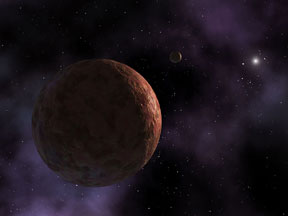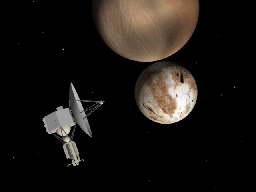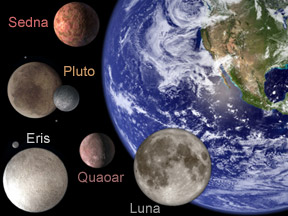Click on image for full size
Image courtesy NASA/JPL-Caltech/R. Hurt (SSC-Caltech)
New planetoid named Sedna discovered
News story originally written on March 17, 2004
Astronomers have announced the discovery of a large new planetoid named Sedna. Mike Brown of the California Institute of Technology, Chad Trujillo of the Gemini Observatory in Hawaii, and David Rabinowitz of Yale University in Connecticut discovered Sedna in November 2003. The astronomers cannot be certain of the exact size of the new planetoid, but they believe it is the largest object discovered in our Solar System since the discovery of Pluto in 1930. Sedna is also the furthest object from the Sun that has been found within our Solar System.
Sedna is probably a huge ball of ice somewhere between 1,280 and 1,760 km (800 and 1,100 miles) in diameter. Sedna is remarkably reddish in color. Astronomers think that exposure to radiation over extremely long times may have altered the chemistry of some of the compounds within the ice, turning them red.
Sedna orbits on the fringe of the known Solar System. It is currently at a distance of about 90 Astronomical Units (AU) from the Sun, more than twice as far away as Pluto. Its orbit is highly elliptical, and carries it around the Sun once every 10,500 years. It will reach perihelion (closest approach to the Sun) in 72 years at a distance of 76 AU, then slowly move away towards its extreme aphelion distance of 900 AU. Numerous similar icy planetoids, known as a group as Kuiper Belt Objects (KBO) or Trans-Neptunian Objects (TNO), have been found in the last decade. However, the TNOs seem to orbit within about 50 AU from the Sun, thus Sedna appears not to belong to that group. An area much further from the Sun, called the Oort Cloud, is thought to exist and be the source of many long period comets. Sedna does not seem to orbit quite far enough out to be part of the Oort Cloud, however, and scientists are trying to figure out how this new planetoid fits in to their big picture views of our Solar System.
Sedna's name comes from an Inuit myth about a sea goddess. A name from an Arctic culture seems appropriate for this icy world that orbits at the frigid fringe of our Solar System. Sedna, whose official name is 2003 VB12, was discovered with the 48-inch Samuel Oschin Telescope at Caltech's Palomar Observatory near San Diego. Since Sedna may be nearly as large as Pluto, its discovery will likely add fuel to the debate over whether Pluto should really be called a planet.












